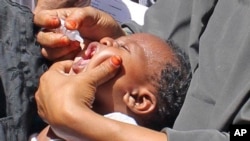NAIROBI, KENYA —
Somalia’s Ministry of Health confirms there are now 94 cases of polio in south-central Somalia and the outbreak is showing no signs of slowing down. New cases of the disease near the border with Ethiopia have also put that country at risk.
The polio outbreak, first identified in May, is spreading throughout Somalia, according to Dr. Yassin Nur, head of immunization at Somalia’s Ministry of Health.
He said another case also has been confirmed in the autonomous region of Somaliland, close to Ethiopia, and could easily be transmitted across the border.
“The risk is there,” Nur said. “Not to mention that Ethiopia is having a very long border and porous border with Somalia and it would be very easy to have the outbreak in Ethiopia.”
Another 10 cases of polio also have been confirmed across the border with Kenya, in the Dadaab refugee camps.
Before the new outbreak, polio had been nearly eradicated across the world, with active cases reported only in three countries: Afghanistan, Pakistan and Nigeria.
But the U.N. children’s agency UNICEF said that in May, a two-year-old girl in Somalia was confirmed to have contracted polio, becoming the first case in the country since 2007.
According to Nur, the population of internally displaced people, who number more than one million in Somalia, are most at risk of contracting the virus that causes polio.
The constant movement of people raises the risk of spreading the disease.
“The problem is this movement between Somalia and Kenya, between Somalia and Ethiopia,” Nur said. “Whether they are IDPs or not, the movement of the people is the one that worries us.
Nur is hopeful a vaccination campaign launched in coordination with U.N. agencies, as well as local and international organizations, will be able to “limit and control” the transmission of the disease.
According to the U.N. almost four million people have received a polio vaccination in Somalia since May.
Children are most at risk of contracting the disease, which has no cure and can paralyze those who are infected.
The polio outbreak, first identified in May, is spreading throughout Somalia, according to Dr. Yassin Nur, head of immunization at Somalia’s Ministry of Health.
He said another case also has been confirmed in the autonomous region of Somaliland, close to Ethiopia, and could easily be transmitted across the border.
“The risk is there,” Nur said. “Not to mention that Ethiopia is having a very long border and porous border with Somalia and it would be very easy to have the outbreak in Ethiopia.”
Another 10 cases of polio also have been confirmed across the border with Kenya, in the Dadaab refugee camps.
Before the new outbreak, polio had been nearly eradicated across the world, with active cases reported only in three countries: Afghanistan, Pakistan and Nigeria.
But the U.N. children’s agency UNICEF said that in May, a two-year-old girl in Somalia was confirmed to have contracted polio, becoming the first case in the country since 2007.
According to Nur, the population of internally displaced people, who number more than one million in Somalia, are most at risk of contracting the virus that causes polio.
The constant movement of people raises the risk of spreading the disease.
“The problem is this movement between Somalia and Kenya, between Somalia and Ethiopia,” Nur said. “Whether they are IDPs or not, the movement of the people is the one that worries us.
Nur is hopeful a vaccination campaign launched in coordination with U.N. agencies, as well as local and international organizations, will be able to “limit and control” the transmission of the disease.
According to the U.N. almost four million people have received a polio vaccination in Somalia since May.
Children are most at risk of contracting the disease, which has no cure and can paralyze those who are infected.









